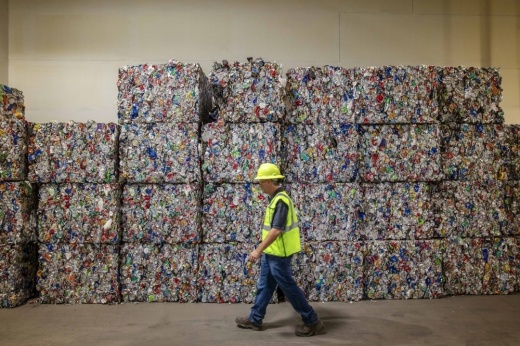In September, the city entered an agreement to partner with WM, formerly known as Waste Management, a waste disposal company.
WM plans to build a $48 million materials recovery facility which will handle, sort and ship recyclable materials in New Braunfels.
City department officials are also anticipating implementing new technology that will help improve efficiencies for residential waste and recycling pickup.
Two-minute impact
Since 2007, the city’s recycling trucks have been driving to material recovery facilities in San Antonio multiple times a day.
The city spent nearly $245,000 on fuel in its recycling division in 2022; it anticipates the new local recovery facility will improve the efficiency of its recycling operations and the safety of its drivers.
Construction on the WM Mesquite Creek materials recovery facility in New Braunfels is slated to begin by the end of the year and be completed around the end of 2024.
“The area continues to grow, and as WM continues to build our services across the area, [New Braunfels] just looked like it was going to be a very good fit, and the city has been very receptive,” WM Director of Public Affairs Lisa Doughty said.
Located near the Mesquite Creek Landfill and Gas-To-Energy Plant on Kohlenberg Road, the development will be a “game changer,” city Solid Waste Manager Elizabeth Tyler said.
After completing its pickup route, the New Braunfels recycling trucks will unload all of the collected material at the recovery facility, where it will be sent on a large conveyor belt to a presort room where sorters will work by hand to remove items that should not have been disposed of in blue bins.
Materials such as paper, cans and bottles will then be separated before being run through an Eddy current, an electric current that pulls materials with aluminum off the conveyor belt and into a metal-only stream.
The sorted materials will then be compacted into bales and shipped around the county to get a second life by being made into a new material, such as carpet, flooring and apparel, according to WM.
The development will also feature an education center, office space and a community drop-off center.
What you need to know
New Braunfels has a landfill, but not a recycling plant. The city’s new state-of-the-art facility will be equipped with 16 optical sorters—devices that use cameras and lasers to identify and properly sort materials discarded at the center.
The facility will help sort the thousands of tons of materials recycled by New Braunfels every year.
“We see the new [materials recovery facility] as being beneficial to everyone from a waste management perspective,” Doughty said.
New Braunfels recycling statistics of note include:
• $12.8 million was the fiscal year 2022-23 operating budget for solid waste and recycling department
• 30.31% of recycling collected was considered contaminated over the past five years
• 3,000 tons of green waste (plant trimmings, branches, etc.) collected in 2022
• 4,771 tons of recycling disposed of in September 2023
• 735 tons of recycling diverted from the landfill in September 2023
Sorting out details
Through the city’s partnership with WM, Tyler said the department’s officials are dedicating more resources toward educating residents about recycling responsibly.
“Especially when it comes to recycling, the success of these programs hinges on educated participation by our residents,” Tyler said. “So we want to make sure that New Braunfels has every opportunity to be successful.”
Department staff plan to participate in more events throughout the community, such as homeowners association meetings and neighborhood events, to increase education efforts and ensure they are informing residents about best practices.
Tyler said city officials are working hard to serve the community and are taking steps to ensure they are prepared to meet the challenge of “undeniable” growth.
Diving in deeper
The solid waste and recycling department is also anticipating the implementation of new software called Routeware by next October. Tyler said truck drivers are still using paper maps of their routes during residential pickup.
With how dynamic the landscape of the city is, Tyler said the new software will impact every element of operations by digitizing routes and is anticipated to streamline operations, improve efficiency, balance routes and reduce turnover.
“Our goal is to be able to keep as much material out of the landfill [as possible] and be able to give it a second life,” Doughty said.
Learn more
Tyler said many residents take part in “wishcycling,” in which nonrecyclable items are disposed of by people who have good intentions but add contaminants to their bins.
Recycling rates are also influenced by the rate of contamination due to the potential impact on the recycling processing fee to the city.
Over the past five years, the city has had an average contamination rate of 30.31%. Tyler said she would like to see that number drop to be between 10%-19%.
“I would say that the rate of contamination referenced here is on the mid-to-high end of the contamination spectrum for cities who offer recycling services,” said Chris Cox, manager of public-sector solutions at WM. “But what I’ll say is many, many communities are making great strides to educate on proper recycling.”
One more thing
Not everything that is recyclable is considered blue bin recyclable, according to the city.
• Recycle clean bottles, cans, paper and cardboard.
• Keep food, liquid and plastic bags out of recycling.
• Do not bag recyclables in plastic.





